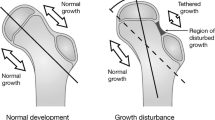Abstract
Purpose
Lateral growth arrest is recognised as the most common form of avascular necrosis (AVN) seen in the management of developmental dysplasia of the hip (DDH). The purpose of this report is to present a new technique that is of benefit in the early identification and subsequent radiological monitoring of lateral growth arrest and which may permit appropriate timely surgical intervention.
Methods
We performed a retrospective review of the medical records and serial radiographs of 11 patients (three males and eight females) with lateral growth disturbance in the proximal femoral physis. We devised a new technique (named the ‘Tilt angle’) for serial radiographic observation of lateral growth arrest.
Results
This study included 11 hips in 11 patients. Ten patients had screw epiphyseodesis performed after progression of lateral growth arrest was noted. One patient did not have screw epiphyseodesis but the results for this patient are included, as they provide an interesting ‘control’ case for comparison. The average age of screw epiphyseodesis was 12 years. Seven patients demonstrated improvement in their tilt angle following screw epiphyseodesis (i.e. less valgus), one showed no change and two continued to decline.
Conclusions
Using a new technique to monitor the progression of lateral growth arrest, we noted that screw epiphyseodesis can be used for guided growth of the proximal femoral physis. This technique can be employed for serial radiographic observation of lateral growth arrest and can guide the clinician on the optimal timing of screw epiphyseodesis. Further studies are needed in order to clarify the optimal timing of screw epiphyseodesis.







Similar content being viewed by others
References
Kalamchi A, MacEwen GD (1980) Avascular necrosis following treatment of congenital dislocation of the hip. J Bone Joint Surg Am 62:876–888
Bland JM, Altman DG (1986) Statistical methods for assessing agreement between two methods of clinical measurement. Lancet 1:307–310
Allen RP (1962) Ischemic necrosis following treatment of hip “dysplasia”. JAMA 180:497–499
Gage JR, Winter RB (1972) Avascular necrosis of the capital femoral epiphysis as a complication of closed reduction of congenital dislocation of the hip. A critical review of twenty years’ experience at Gillette Children’s Hospital. J Bone Joint Surg Am 54:373–388
Salter RB, Kostuik J, Dallas S (1969) Avascular necrosis of the femoral head as a complication of treatment for congenital dislocation of the hip in young children: a clinical and experimental investigation. Can J Surg 12:44–61
Weiner DS, Hoyt WA Jr, O’Dell HW (1977) Congenital dislocation of the hip. The relationship of premanipulation traction and age to avascular necrosis of the femoral head. J Bone Joint Surg Am 59:306–311
Gage JR, Cary JM (1980) The effects of trochanteric epiphyseodesis on growth of the proximal end of the femur following necrosis of the capital femoral epiphysis. J Bone Joint Surg Am 62:785–794
Joo SY, Oh CW, Grissom L et al (2009) Three-dimensional computerized tomographic analysis of the deformity of lateral growth disturbance of proximal femoral physis. J Pediatr Orthop 29(6):540–546
Oh CW, Joo SY, Kumar SJ et al (2009) A radiological classification of lateral growth arrest of the proximal femoral physis after treatment for developmental dysplasia of the hip. J Pediatr Orthop 29(4):331–335
Author information
Authors and Affiliations
Corresponding author
About this article
Cite this article
McGillion, S., Clarke, N.M.P. Lateral growth arrest of the proximal femoral physis: a new technique for serial radiological observation. J Child Orthop 5, 201–207 (2011). https://doi.org/10.1007/s11832-011-0339-1
Received:
Accepted:
Published:
Issue Date:
DOI: https://doi.org/10.1007/s11832-011-0339-1




